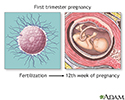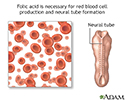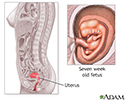Folate deficiency
Deficiency - folic acid; Folic acid deficiencyFolate deficiency means you have a lower-than-normal amount of folic acid, a type of vitamin B, in your blood.
Folic acid
Folic acid and folate are both terms for a type of B vitamin (vitamin B9). The terms folic acid and folate are often used interchangeably. Folate is...

Causes
Folic acid (vitamin B9) works with vitamin B12 and vitamin C to help the body break down, use, and make new proteins. The vitamin helps form red and white blood cells. It also helps produce DNA, the building block of the human body, which carries genetic information.
Folic acid is a water-soluble type of vitamin B. This means it is not stored in the fat tissues of the body. Leftover amounts of the vitamin leave the body through the urine.
Because folate is not stored in the body in large amounts, your blood levels will get low after only a few weeks of eating a diet low in folate. Folate is found primarily in legumes, leafy greens, eggs, beets, bananas, citrus fruits, and liver.
Contributors to folate deficiency include:
- Diseases in which folic acid is not well absorbed in the digestive system (such as celiac disease or Crohn disease)
Celiac disease
Celiac disease is an autoimmune condition that damages the lining of the small intestine. This damage comes from a reaction to eating gluten. This ...
 ImageRead Article Now Book Mark Article
ImageRead Article Now Book Mark ArticleCrohn disease
Crohn disease is a disease where parts of the digestive tract become inflamed. It most often involves the lower end of the small intestine and the be...
 ImageRead Article Now Book Mark Article
ImageRead Article Now Book Mark Article - Drinking too much alcohol
- Eating overcooked fruits and vegetables. Folic acid can be easily destroyed by heat.
-
Hemolytic anemia
Hemolytic anemia
Anemia is a condition in which the body does not have enough healthy red blood cells. Red blood cells provide oxygen to body tissues. Normally, red ...
 ImageRead Article Now Book Mark Article
ImageRead Article Now Book Mark Article - Certain medicines (such as phenytoin, sulfasalazine, or trimethoprim-sulfamethoxazole)
- Eating a diet that does not include enough fruits and vegetables
- Kidney dialysis
Symptoms
Folic acid deficiency may cause:
- Fatigue, irritability, or diarrhea
- Poor growth
- Smooth and tender tongue
Exams and Tests
Folate deficiency can be diagnosed with a blood test. Pregnant women commonly have this blood test at prenatal checkups.
Blood test
Folic acid is also called vitamin B9. This article discusses the test to measure the amount of folic acid in the blood. It is often done together w...
Possible Complications
Complications include:
-
Anemia (low red blood cell count)
Anemia
Anemia is a condition in which the body does not have enough healthy red blood cells. Red blood cells provide oxygen to body tissues. Different type...
 ImageRead Article Now Book Mark Article
ImageRead Article Now Book Mark Article - Low levels of white blood cells and platelets (in severe cases)
In folate-deficiency anemia, the red blood cells are abnormally large (megaloblastic).
Folate-deficiency anemia
Folate-deficiency anemia is a decrease in red blood cells (anemia) due to a lack of folate. Folate is a type of B vitamin. It is also called folic ...

Pregnant women need to get enough folic acid. The vitamin is important to the growth of the fetus's spinal cord and brain. Folic acid deficiency can cause severe birth defects known as neural tube defects. The Recommended Dietary Allowance (RDA) for folate during pregnancy is 600 micrograms (µg)/day.
Neural tube defects
Meningocele repair (also known as myelomeningocele repair) is surgery to repair birth defects of the spine and spinal membranes. Meningocele and mye...

Prevention
The best way to get vitamins your body needs is to eat a balanced diet. Most people in the United States eat enough folic acid because it is plentiful in the food supply.
Balanced diet
By following the US Department of Agriculture's food guide, called MyPlate, you can make healthier food choices. The newest guide encourages you to ...

Folate occurs naturally in the following foods:
- Beans and legumes
- Citrus fruits and juices
- Dark green leafy vegetables such as spinach, asparagus, and broccoli
- Liver
- Mushrooms
- Poultry, pork, and shellfish
- Wheat bran and other whole grains
The recommended daily amount of folic acid for adults is 400 µg of folate daily. Women who may become pregnant should take folic acid supplements to ensure that they get enough each day.
Folic acid supplements
Taking folic acid before and during pregnancy can reduce the risk for certain birth defects. These include spina bifida, anencephaly, and some heart...

Specific recommendations depend on a person's age, sex, and other factors (such as pregnancy and lactation). Many foods, such as fortified breakfast cereals, now have extra folic acid added to help prevent birth defects.
Specific recommendations
Folic acid and folate are both terms for a type of B vitamin (vitamin B9). The terms folic acid and folate are often used interchangeably. Folate is...

References
Antony AC. Megaloblastic anemias. In: Hoffman R, Benz EJ, Silberstein LE, et al, eds. Hematology: Basic Principles and Practice. 8th ed. Philadelphia, PA: Elsevier; 2023:chap 40.
Koppel BS, Weimer LH, Daras M. Nutritional and alcohol-related neurologic disorders. In: Goldman L, Cooney KA, eds. Goldman-Cecil Medicine. 27th ed. Philadelphia, PA: Elsevier; 2024:chap 384.
Murphy MF, Pasi KJ, Roy N. Haematology. In: Feather A, Randall D, Waterhouse M, eds. Kumar and Clark's Clinical Medicine. 10th ed. Philadelphia, PA: Elsevier; 2021:chap 16.
Samuels P. Hematologic complications of pregnancy. In: Landon MB, Galan HL, Jauniaux ERM, et al, eds. Gabbe's Obstetrics: Normal and Problem Pregnancies. 8th ed. Philadelphia, PA: Elsevier; 2021:chap 44.
-
First trimester of pregnancy - illustration
The first trimester of pregnancy is the first three months after conception. Signs of early pregnancy are missed menstrual periods, fatigue, breast enlargement, abdominal distention, and nausea. During this period of time all organ development takes place so the fetus is most susceptible to damage from toxins, drugs, and infections.
First trimester of pregnancy
illustration
-
Folic acid - illustration
Studies show that an increase in the mother's dietary folic acid before conception and during the first month of pregnancy reduces the risk of having a child with a neural tube defect. The recommendation is that women of childbearing years take a daily folic acid supplement.
Folic acid
illustration
-
Early weeks of pregnancy - illustration
The first trimester of a pregnancy is a time of incredible growth and development. A 7-week fetus will have begun to develop all essential organs.
Early weeks of pregnancy
illustration
-
First trimester of pregnancy - illustration
The first trimester of pregnancy is the first three months after conception. Signs of early pregnancy are missed menstrual periods, fatigue, breast enlargement, abdominal distention, and nausea. During this period of time all organ development takes place so the fetus is most susceptible to damage from toxins, drugs, and infections.
First trimester of pregnancy
illustration
-
Folic acid - illustration
Studies show that an increase in the mother's dietary folic acid before conception and during the first month of pregnancy reduces the risk of having a child with a neural tube defect. The recommendation is that women of childbearing years take a daily folic acid supplement.
Folic acid
illustration
-
Early weeks of pregnancy - illustration
The first trimester of a pregnancy is a time of incredible growth and development. A 7-week fetus will have begun to develop all essential organs.
Early weeks of pregnancy
illustration
Review Date: 8/28/2023
Reviewed By: Todd Gersten, MD, Hematology/Oncology, Florida Cancer Specialists & Research Institute, Wellington, FL. Review provided by VeriMed Healthcare Network. Also reviewed by David C. Dugdale, MD, Medical Director, Brenda Conaway, Editorial Director, and the A.D.A.M. Editorial team.




